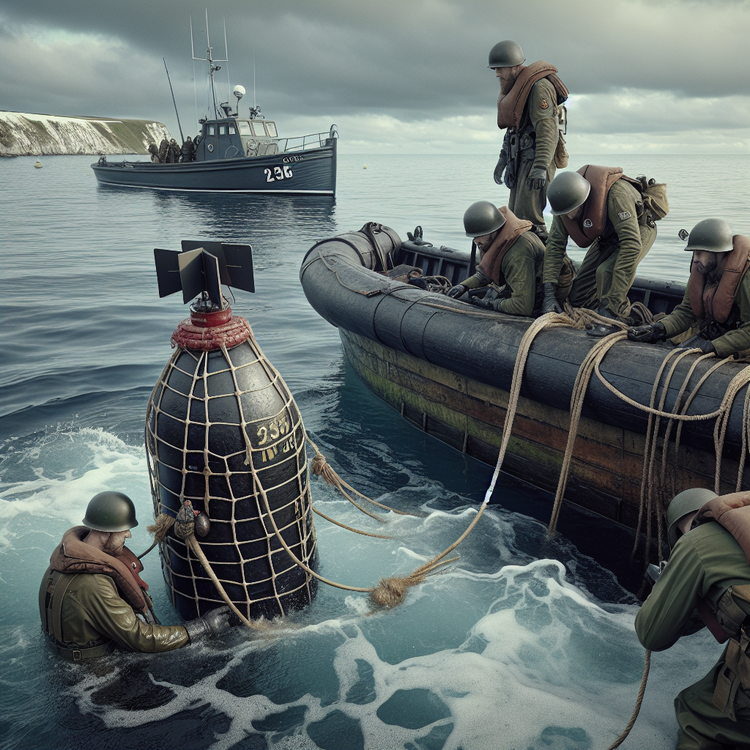A fisherman found a very old bomb in his net near an island called Langeland in Denmark. People who are good at handling bombs came and took the bomb into the water. They put a small bomb on the big bomb to make it safe. Then they made the bomb go “boom” under the water. It was a big splash 15 meters deep.
The bomb was from a time when many countries were fighting, called World War Two. The fisherman told the people who could help, and they knew what to do. They made sure no one would get hurt by the bomb. They did their job very well and made the bomb go “boom” in the water. People who know about bombs are still looking for more in the water to keep everyone safe.
Original news source: World War Two bomb detonated off coast of Denmark (BBC)
Listen:
Slow
Normal
Fast
Vocabulary:
| 1 | bomb | Something that goes “boom” and can hurt people |
| 2 | fisherman | A person who catches fish |
| 3 | net | Something you use to catch fish in the water |
| 4 | island | A piece of land surrounded by water |
| 5 | Langeland | The name of the island where the bomb was found |
| 6 | Denmark | The name of the country where the bomb was found |
| 7 | handle | To touch and move something carefully |
| 8 | safe | Not dangerous or harmful |
| 9 | splash | The sound water makes when something falls into it |
| 10 | hurt | To cause pain or injury to someone |
Group or Classroom Activities
Warm-up Activities:
– Charades
Instructions: Divide the class into small groups. Give each group a word or phrase related to the article (e.g. fisherman, bomb, World War Two). One student from each group acts out the word or phrase without speaking, while the other group members try to guess what it is.
– Word Association
Instructions: Write the word “bomb” on the board. Ask the students to quickly brainstorm as many words as they can that are related to the word “bomb” (e.g. explosion, danger, war). Encourage them to share their answers and discuss the connections between the words.
– Sketch It
Instructions: Give each student a piece of paper and ask them to draw a picture related to the article (e.g. a fisherman, a bomb, an explosion). After a few minutes, have the students share their drawings with the class and explain what they have drawn.
– Vocabulary Pictionary
Instructions: Write a selection of vocabulary words from the article (e.g. fisherman, bomb, net) on separate pieces of paper. Divide the class into small groups and give each group a set of vocabulary words. One student from each group picks a word and draws it on the board, while the other group members try to guess what it is.
– Speed Summarizing
Instructions: Divide the class into pairs. Give each pair a copy of the article. Set a timer for two minutes and ask the students to read the article quickly. After the two minutes, one student from each pair has to summarize the article to their partner in one minute or less. Then, the roles switch and the other student summarizes the article. Finally, ask a few pairs to share their summaries with the class.
Comprehension Questions:
1. What did the fisherman find in his net?
2. Where was the bomb found?
3. What did the people do to make the bomb safe?
4. Where did they make the bomb go “boom”?
5. What was the bomb from?
6. Who did the fisherman tell about the bomb?
7. Why are people still looking for more bombs in the water?
Go to answers ⇩
Listen and Fill in the Gaps:
A fisherman (1)______ a very old bomb in his net near an island called Langeland in Denmark. People who are good at (2)______ bombs came and took the bomb into the water. They put a small bomb on the big bomb to make it safe. Then they made the bomb go “boom” under the water. It was a big splash 15 meters (3)______.
The bomb was from a (4)______ when many countries were fighting, called World War Two. The fisherman told the people who could help, and they (5)______ what to do. They made sure no one would get (6)______ by the bomb. They did their job very well and made the bomb go “boom” in the water. (7)______ who know about (8)______ are still looking for more in the water to keep everyone safe.
Go to answers ⇩
Discussion Questions:
Students can ask a partner these questions, or discuss them as a group.
1. What did the fisherman find in his net?
2. How do you think the fisherman felt when he found the bomb?
3. What do you think the bomb looked like?
4. Have you ever seen a bomb before? Why or why not?
5. How do you think the people felt when they saw the bomb?
6. Do you think it was dangerous to have the bomb in the net? Why or why not?
7. How did the people make sure no one would get hurt by the bomb?
8. How do you think the bomb sounded when it went “boom”?
9. Would you like to see the bomb go “boom” in the water? Why or why not?
10. Do you think it’s important for people to look for more bombs in the water? Why or why not?
11. What do you think the people who handle bombs do to stay safe?
12. How would you feel if you found a bomb in your net? Why?
Individual Activities
Vocabulary Meanings:
Match each word to its meaning.
Words:
1. bomb
2. fisherman
3. net
4. island
5. Langeland
6. Denmark
7. handle
8. safe
9. splash
10. hurt
Meanings:
(A) The name of the island where the bomb was found
(B) To touch and move something carefully
(C) Something you use to catch fish in the water
(D) The sound water makes when something falls into it
(E) Not dangerous or harmful
(F) To cause pain or injury to someone
(G) A person who catches fish
(H) Something that goes “boom” and can hurt people
(I) The name of the country where the bomb was found
(J) A piece of land surrounded by water
Go to answers ⇩
Multiple Choice Questions:
1. Where did the fisherman find the bomb?
(a) In the sky
(b) In his house
(c) In the forest
(d) In his net near an island called Langeland in Denmark
2. What did the people do to make the bomb safe?
(a) They threw the bomb away
(b) They kept the bomb in their pocket
(c) They gave the bomb to the fisherman
(d) They put a small bomb on the big bomb and made it go “boom” under the water
3. When was the bomb from?
(a) World War Two
(b) World War One
(c) Last year
(d) Yesterday
4. Who did the fisherman tell about the bomb?
(a) His friends
(b) People who could help
(c) His dog
(d) Nobody
5. What did the people do to make sure no one would get hurt by the bomb?
(a) They ran away
(b) They hid in a cave
(c) They did their job very well and made the bomb go “boom” in the water
(d) They ignored the bomb
6. What are people who know about bombs still looking for?
(a) Fish in the water
(b) More bombs in the water
(c) Shells in the water
(d) Boats in the water
7. Where did the bomb go “boom”?
(a) Under the water
(b) In the sky
(c) On the land
(d) In the fisherman’s net
8. What did the bomb make when it went “boom”?
(a) A loud noise
(b) A small splash
(c) A big splash
(d) A big fire
Go to answers ⇩
True or False Questions:
1. The bomb was found outside Denmark.
2. A fisherman found an old bomb in his net near an island.
3. People who are good at handling bombs came to help.
4. They put a small bomb on the big bomb to make it safe.
5. The bomb was from a time when many countries were fighting.
6. The bomb was made to go “boom” above the water.
7. People are no longer looking for more bombs in the water to keep everyone safe.
8. The people did a terrible job and made sure everyone would get hurt.
Go to answers ⇩
Write a Summary:
Write a summary of this news article in two sentences.
Check your writing now with the best free AI for English writing!
Writing Questions:
Answer the following questions. Write as much as you can for each answer.
Check your answers with our free English writing assistant!
1. What did the fisherman find in his net?
2. Who came to help with the bomb?
3. What did they do to make the bomb safe?
4. Where did they make the bomb go “boom”?
5. Why are people still looking for more bombs in the water?
Answers
Comprehension Question Answers:
1. What did the fisherman find in his net?
The fisherman found a bomb in his net.
2. Where was the bomb found?
The bomb was found near an island called Langeland in Denmark.
3. What did the people do to make the bomb safe?
The people put a small bomb on the big bomb to make it safe.
4. Where did they make the bomb go “boom”?
They made the bomb go “boom” under the water, 15 meters deep.
5. What was the bomb from?
The bomb was from World War Two, a time when many countries were fighting.
6. Who did the fisherman tell about the bomb?
The fisherman told the people who could help about the bomb.
7. Why are people still looking for more bombs in the water?
People are still looking for more bombs in the water to keep everyone safe.
Go back to questions ⇧
Listen and Fill in the Gaps Answers:
(1) found
(2) handling
(3) deep
(4) time
(5) knew
(6) hurt
(7) People
(8) bombs
Go back to questions ⇧
Vocabulary Meanings Answers:
1. bomb
Answer: (H) Something that goes “boom” and can hurt people
2. fisherman
Answer: (G) A person who catches fish
3. net
Answer: (C) Something you use to catch fish in the water
4. island
Answer: (J) A piece of land surrounded by water
5. Langeland
Answer: (A) The name of the island where the bomb was found
6. Denmark
Answer: (I) The name of the country where the bomb was found
7. handle
Answer: (B) To touch and move something carefully
8. safe
Answer: (E) Not dangerous or harmful
9. splash
Answer: (D) The sound water makes when something falls into it
10. hurt
Answer: (F) To cause pain or injury to someone
Go back to questions ⇧
Multiple Choice Answers:
1. Where did the fisherman find the bomb?
Answer: (d) In his net near an island called Langeland in Denmark
2. What did the people do to make the bomb safe?
Answer: (d) They put a small bomb on the big bomb and made it go “boom” under the water
3. When was the bomb from?
Answer: (a) World War Two
4. Who did the fisherman tell about the bomb?
Answer: (b) People who could help
5. What did the people do to make sure no one would get hurt by the bomb?
Answer: (c) They did their job very well and made the bomb go “boom” in the water
6. What are people who know about bombs still looking for?
Answer: (b) More bombs in the water
7. Where did the bomb go “boom”?
Answer: (a) Under the water
8. What did the bomb make when it went “boom”?
Answer: (c) A big splash
Go back to questions ⇧
True or False Answers:
1. The bomb was found outside Denmark. (Answer: False)
2. A fisherman found an old bomb in his net near an island. (Answer: True)
3. People who are good at handling bombs came to help. (Answer: True)
4. They put a small bomb on the big bomb to make it safe. (Answer: True)
5. The bomb was from a time when many countries were fighting. (Answer: True)
6. The bomb was made to go “boom” above the water. (Answer: False)
7. People are no longer looking for more bombs in the water to keep everyone safe. (Answer: False)
8. The people did a terrible job and made sure everyone would get hurt. (Answer: False)
Go back to questions ⇧














